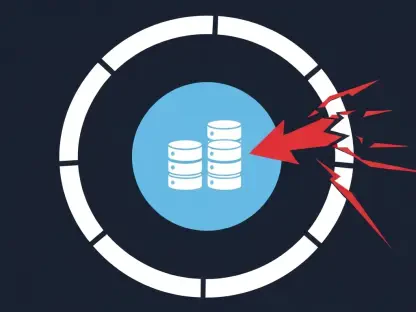Imagine a bustling e-commerce platform handling millions of transactions daily, only to be crippled by a sophisticated cyberattack that slips past its defenses, exposing sensitive customer data. This scenario is becoming all too common as web-based threats grow in complexity and frequency. Web Application Firewalls (WAFs) have emerged as essential tools in the fight against such dangers, designed to shield web applications from malicious activities by filtering out harmful traffic. Positioned as a barrier between applications and potential attackers, WAFs are widely adopted across industries to safeguard critical operations. This review delves into their mechanisms, effectiveness, and the surprising vulnerabilities that challenge their reputation as impenetrable defenses.
Core Features and Mechanisms of WAFs
Traffic Filtering and Pattern Recognition
At the heart of WAF functionality lies the ability to scrutinize incoming traffic and employ pattern-matching techniques to detect and block known malicious payloads. By analyzing requests against a database of attack signatures, these systems effectively thwart common threats like SQL injection and cross-site scripting (XSS). This foundational mechanism ensures that harmful scripts or queries are intercepted before they reach the application layer, maintaining a first line of defense. The significance of such filtering cannot be overstated, as it forms the bedrock of WAF reliability in high-stakes environments.
Beyond basic detection, WAFs often rely on regularly updated rule sets to stay ahead of emerging attack patterns. This dynamic approach allows them to address vulnerabilities in real time, offering protection against exploits that target outdated software or misconfigurations. However, the effectiveness of pattern recognition hinges on the accuracy and comprehensiveness of these rules, which can sometimes lag behind the ingenuity of attackers crafting novel methods to bypass detection.
Machine Learning and Adaptive Innovations
Modern WAFs have evolved to incorporate machine learning algorithms, enabling them to identify anomalies and adapt to previously unseen threats. Unlike static rule-based systems, these advanced tools analyze traffic behavior over time, learning to distinguish between legitimate user actions and potential attacks. This capability promises a significant leap in security, particularly against zero-day exploits that lack predefined signatures, positioning adaptive WAFs as a forward-thinking solution.
Research in recent years highlights the potential of these systems to enhance protection by reducing false positives and improving response times to complex threats. Yet, real-world performance often reveals gaps, with some machine learning models struggling against obfuscated or highly tailored attacks. While the technology holds immense promise, its practical impact depends on continuous refinement and integration with broader security frameworks to address evolving challenges.
Emerging Concerns in WAF Effectiveness
The assumption of WAF invincibility has been shaken by recent studies exposing critical weaknesses in their configurations. Security researchers testing 17 major vendors found that many systems fail to counter sophisticated attacks, with bypass rates climbing as threat complexity increases. Techniques like HTTP parameter pollution, which exploit how applications handle duplicate input parameters, have proven particularly effective at evading detection, raising serious doubts about current WAF capabilities.
A troubling trend is the growing success of these bypass methods, with rates soaring from under 20% for basic attacks to over 70% for advanced strategies. This discrepancy suggests that while WAFs can handle straightforward threats, they often crumble under nuanced or layered assault tactics. Such findings underscore a pressing need to reassess the design principles behind these tools and their ability to keep pace with attacker innovation.
Moreover, an over-reliance on WAFs as the primary defense mechanism pervades many industries, despite mounting evidence of their shortcomings. Organizations frequently deploy these systems expecting comprehensive protection, only to discover that fundamental flaws in configuration or logic leave them exposed. This misplaced confidence highlights a broader misunderstanding of WAF limitations and the necessity for supplementary security measures.
Real-World Applications and Vulnerabilities
Across sectors like e-commerce, finance, and healthcare, WAFs play a pivotal role in protecting sensitive data and transactions from cyber threats. These industries depend on web applications for critical functions, making robust security paramount to prevent breaches that could compromise customer trust or regulatory compliance. WAFs are often deployed to filter traffic at scale, ensuring that malicious requests are blocked before they disrupt operations or steal information.
However, real-world penetration testing reveals significant gaps in their protective capabilities. In scenarios involving ASP.NET applications, for instance, attackers have successfully exploited XSS vulnerabilities through parameter pollution, bypassing even tightly configured WAFs. Such cases demonstrate how attackers split malicious code across multiple inputs, exploiting application parsing behaviors that firewalls fail to anticipate or detect.
These examples illuminate a stark disparity between the intended role of WAFs as impenetrable shields and their actual performance under dynamic conditions. The reliance on static analysis or isolated parameter checks often leaves blind spots that skilled adversaries can exploit with relative ease. This reality serves as a reminder that while WAFs are valuable, they cannot address every threat in isolation, especially in complex, high-traffic environments.
Challenges and Limitations of WAFs
One of the most glaring technical shortcomings of WAFs is their inability to fully understand how web applications interpret and process input data. Many systems analyze parameters individually, missing the broader context of how frameworks like ASP.NET concatenate duplicate entries, often with delimiters that attackers manipulate to execute harmful code. This blind spot allows seemingly benign inputs to combine into dangerous payloads, undermining the firewall’s effectiveness.
Specific vulnerabilities, such as the handling of concatenated parameters, reveal how attackers craft exploits that evade traditional detection methods. By distributing malicious content across multiple fields, adversaries ensure that no single input triggers an alert, while the application itself merges them into executable scripts. This tactic highlights a critical design flaw in many WAFs, which fail to mirror the parsing logic of the applications they protect, leaving a window for exploitation.
Organizationally, a pervasive misconception persists that WAFs offer a complete security solution, absolving the need for deeper measures like secure coding practices. This belief often results in inadequate training or resource allocation toward addressing root causes of vulnerabilities. Educating stakeholders on the supplementary nature of WAFs and the importance of a multi-layered defense strategy remains a significant hurdle, requiring a cultural shift in how cybersecurity is approached.
Future Outlook for Web Application Firewalls
Looking ahead, the evolution of WAFs may hinge on advancements in parsing logic and deeper integration with other security tools to form a more cohesive defense ecosystem. Future iterations could focus on mimicking application-specific behaviors to close existing blind spots, ensuring that input handling discrepancies no longer serve as attack vectors. Such improvements would mark a substantial step toward enhancing their reliability against sophisticated threats.
Equally important is a shift in industry mindset, moving away from viewing WAFs as standalone solutions and toward embracing comprehensive cybersecurity strategies. Addressing underlying issues like insecure coding practices through developer training and robust testing protocols will be essential to reduce reliance on firewalls for primary protection. This holistic approach could redefine how organizations prioritize and allocate resources for long-term security.
As cyber threats continue to evolve, WAFs must adapt to maintain relevance within the broader security landscape. Their role may increasingly involve collaboration with technologies like intrusion detection systems and automated patching tools to create a dynamic, responsive defense framework. Whether these adaptations will suffice against the ingenuity of future attackers remains an open question, but ongoing innovation will be critical to their sustained utility.
Final Reflections on WAF Resilience
This exploration into Web Application Firewalls uncovered a landscape of both promise and peril, as their once-assumed robustness was tested against increasingly cunning cyber threats. Studies exposed alarming vulnerabilities, with bypass techniques like HTTP parameter pollution proving effective against even advanced systems. The over-reliance on WAFs as a singular defense left many organizations exposed, highlighting a gap between expectation and reality.
Moving forward, actionable steps emerged as a priority for those leveraging these tools. Integrating WAFs into a broader security architecture, emphasizing secure development practices, and investing in continuous education became essential recommendations. By addressing root vulnerabilities and fostering collaboration across security layers, businesses could better prepare for the next wave of challenges, ensuring that WAFs served as a valuable component rather than a sole safeguard.









